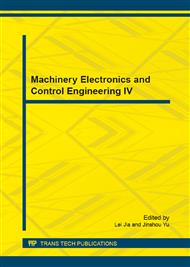[1]
B. O'Regan, M. Grätzel, A low-cost, high-efficiency solar cell based on dye-sensitized colloidal TiO2 fills, Nature, Vol. 353 (1991) 737-740.
DOI: 10.1038/353737a0
Google Scholar
[2]
M. Grätzel, Review Dye-sensitized solar cells, J. Photochem. Photobiol. C, Vol. 4 (2003) 145-153.
Google Scholar
[3]
D. Chen, F. Huang, Y. B. Cheng, R. A. Caruso, Mesoporous Anatase TiO2 Beads with High Surface Areas and Controllable Pore Sizes: A Superior Candidate for High-Performance Dye-Sensitized Solar Cells, Adv. Mater., Vol. 21 (2009) 2206-2210.
DOI: 10.1002/adma.200802603
Google Scholar
[4]
L. Yang and W. W. F. Leung, A scattering layer composed of electrosprayed polydispersed-size nanocrystallite TiO2 for high efficiency dye sensitized solar cells, RSC Adv., Vol. 3 (2013) 25707–25710.
DOI: 10.1039/c3ra40865e
Google Scholar
[5]
Z. S. Wang, H. Kawauchi, T. Kashima and H. Arakawa, Significant influence of TiO2 photoelectrode morphology on the energy conversion efficiency of N719 dye-sensitized solar cell, Chem. Reviews, Vol. 248 (2004) 1381-1389.
DOI: 10.1016/j.ccr.2004.03.006
Google Scholar
[6]
T. Ma, T Kida, M. Akiyama, K. Inous, S. Tsunematsu, K. Yao, H. Noma and E. Abe, Preparation and properties of nanostructured TiO2 electrode by a polymer organic-medium screen-printing technique, Electrochem. commun., Vol. 5 (2003) 369–372.
DOI: 10.1016/s1388-2481(03)00070-5
Google Scholar
[7]
J. H. Kim, S. J. Sung, K. P. Kim and D. K. Hwang, Effect of hot-pressing on an electrospun TiO2 electrode for dye-sensitized solar cells, Appl. phy. exp., Vol. 7 (2014) 072301.
DOI: 10.7567/apex.7.072301
Google Scholar
[8]
D. S. Hwang, H. R. Lee, S. Y. Jang, S. M. Jo and D. H. Kim, Y. S. Seo, D. Y. Kim, Electrospray Preparation of Hierarchically-structured Mesoporous TiO2 Spheres for Use in Highly Efficient Dye-Sensitized Solar Cells, ACS Appl. Mater. Interfaces, Vol. 3 (2011).
DOI: 10.1021/am200517v
Google Scholar
[9]
Y. X. Xu, M. Skotak and M. Hanna, Electrospray encapsulation of water-soluble protein with polylactide. I. Effects of formulations and process on morphology and particle size, J. Microencapsulation, Vol. 23 (2006) 69-78.
DOI: 10.1080/02652040500435048
Google Scholar
[10]
V. Pornsopone, P. Supaphol, R. Rangkupan and S. Tantayanon, Electrospinning of Methacrylate-Based Copolymers: Effects of Solution Concentration and Applied Electrical Potential on Morphological Appearance of As-Spun Fibers, Polym. Eng. Sci., Vol. 45 (2005).
DOI: 10.1002/pen.20354
Google Scholar
[11]
C. Burger, B. S. Hsiao and B. Chu, Annu. Nanofibrous Materials and Their Applications, Rev. Mater. Res., Vol. 36 (2006) 333-368.
DOI: 10.1146/annurev.matsci.36.011205.123537
Google Scholar
[12]
K. S. Sim, S. J. Sung, H. J. Jo, D. H. Jeon, D. H. Kim and J. K. Kang, Electrochemical Investigation of High-Performance Dye-Sensitized Solar Cells Based on Molybdenum for Preparation of Counter Electrode, Int. J. Electrochem. Sci., Vol. 8 (2013).
DOI: 10.1016/s1452-3981(23)12886-0
Google Scholar
[13]
J. Navas, C. Fernandez-Lorenzo, T. Aguilar, R. Alcántara and J. Martín-Calleja, Improving open-circuit voltage in DSSCs using Cu-doped TiO2 as a semiconductor, Physica Status Solidi A, Vol. 209 (2012) 378-385.
DOI: 10.1002/pssa.201127336
Google Scholar
[14]
J. Bisquert and V. S. Vikhrenko, Interpretation of the Time Constants Measured by Kinetic Techniques in Nanostructured Semiconductor Electrodes and Dye-Sensitized Solar Cells, J. Phys. Chem. B, Vol. 108 (2004) 2313-2322.
DOI: 10.1021/jp035395y
Google Scholar
[15]
M. Pan, N. Huang, X. Zhao, J. Fu, and X. Zhong, Enhanced Efficiency of Dye-Sensitized Solar Cell by High Surface Area Anatase-TiO2-Modified P25 Paste, Journal of Nanomaterials, Vol. 2013 (2013) 1-6.
DOI: 10.1155/2013/760685
Google Scholar


